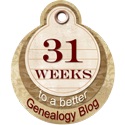The Civil War … in Oklahoma? ~ Part 2
Sharing my understanding of the this article which was emailed to from a new found cousin. The article is
Thanks for stopping by!
Wishing you success in all of your genealogical treasure hunts!
Copyright © 2010 By Cheryl Palmer
"The Site of the Battle of Round Hill, 1861 by Angie Debo." I understand this excerpt was taken from "The Chronicles of Oklahoma."
Annie Heloise Abel published what has been labeled as "the first of her three great volumes" on the Civil War in the Indian Territory. The information she used in this book which was published in 1915, came from Government Archives. This volume also contained a map she reproduced which was drawn by John T. Cox. John was a Special Indian Agent. He made an excellent map which shared how familiar he was with the territory. Opothle Yahola's specific route was detailed on this map, along with where the camps were located. The specific route went across the country and the Cimarron River. The route then partially goes through and around Yale, Cushing, Pawnee and of course the Cimarron River, my families old stomping grounds.(My father told be a story about the Cimarron and his family which I will share at another time.)
The map seemed to settle the location as to where the battlefield (The Battle of Round Mountain) was actually located. The sites had been unmarked and unregarded to this point because there really wasn't any proof as to where they were located. At this stage, Joseph B. Thorburn, the states first historian accepted it and many later historians accepted it also. This included Muriel H. Wright, Grant Foreman and the writer of this article I am going through, Angie Debo. The battle site probably would have stayed at this location except for the researches of a real estate agent, and a young one at that, in Stillwater.
His name was John H. Melton. He was a dealer in farms and a leader of the boy scouts. As a leader of the boy scouts he had traipsed all over the terrain. As a dealer in farms he was aware of the battlefield tradition. He was unaware of the Cox map and the conclusions of the historians, but he began to get affidavits from some of the old settlers. He shared these affidavits with the Payne County Historical Society. The Historical Society felt all avenues should be explored after Melton persisted to they look at the evidence again. The society realized that there still wasn't enough evidence to state exactly where the battle field was. It could be at the Yale site, or it could be at the Keystone site. Finally, a photo copy of a statement by the Confederate Creek Leaders, which had been sitting in files in Washington, came to surface. This was thanks to Angie Debo who made the initial request. Turns out, this document yielded that the Yale site was more than likely where the battlefield was located.
A meeting at the Payne County Historical Society on March 6, 1949 occurred. This meeting was actually a panel discussion which included a couple of Tulsa historians, Mr. Melton, Angie Debo and Miss Wright. No final agreement was reached from discussion. Ola J. Rogers had presented the first evidence that the battlefield was on the Keystone site.
The Society decided upon an extensive search to find additional information. This was announced publicly. Part of the new policy developed by the society included that Angie Debo sum up all of the evidence acquired to that point.
Thanks for stopping by!
Wishing you success in all of your genealogical treasure hunts!
Copyright © 2010 By Cheryl Palmer


Comments
Post a Comment